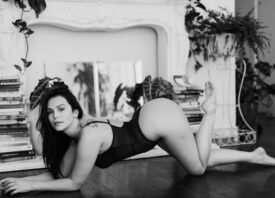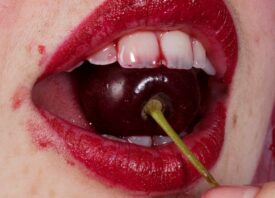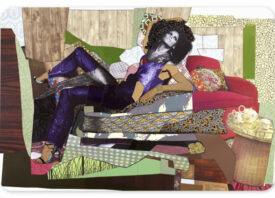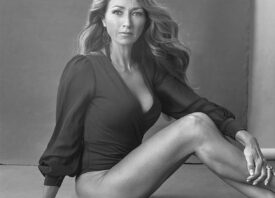Search this site
Tips and Tricks for Boudoir Photography

When you think of boudoir photography, the image that pops into your mind might be a little outdated. “When the genre of boudoir emerged, it was marketed as a gift to a loved one—to titillate or tease a partner—and I think that point of view still exists,” Stephanie Bordas, the artist behind Brooklyn Boudoir, tells me. “But I am trying to expand the definition of boudoir so that women feel empowered to have beautiful photos of themselves, for themselves. You don’t need a person to gift these photos to or a ‘reason’ to take them. You are the reason.”
This idea of creating sensual photos for a client—rather than of them—came up time and again throughout my interviews with artists working in boudoir photography. Any kind of portrait requires trust, but that’s especially true when you’re working in this field. When I asked about all the work that goes on behind the scenes, these photographers told me it’s never about the gear. It all boils down to your ability to make people feel comfortable, beautiful, and free to be themselves.

Know your style.
Having a signature style and approach sets you apart creatively, and it also helps to attract clients who share your vision. With boudoir photography especially, clients want to go into a shoot with a clear idea of what they’re going to get.
“As you are growing your portfolio, and photographing clients, be sure to share the images that represent the work you want to do,” Nomi Ellenson May, the artist behind Boudoir by Nomi, advises. “If someone is looking for a dramatic, studio-lighting vibe, I’m not that photographer. I work with natural light and emphasize an airy feel.
“Gaining clarity for who you are and who you are not makes it easier to redirect a client inquiry if it’s not the right fit. There is always another client coming, which can be reassuring when you don’t want to let a lead go. You are safe to stand by what feels good to you.”

Communicate—a lot.
“Women about to be photographed in their skivvies are sure to be nervous, and it’s your job to put them at ease,” Bordas urges. “Your technical photography work becomes infinitely easier when someone trusts you, so be sure you communicate a lot with your clients before you meet them.
“Tell them everything about the process before they come in so they are not confused by anything. Make sure they know you, what you look like, what you will be doing on the shoot day, and then be sure to deliver on all of these things.” Ask questions, and make sure expectations are crystal clear.

Make it all about the client.
“To me, it’s all about client experience!” Emma Christine tells me. “I want them to feel like they can arrive knowing that I’ve got everything taken care of. They can just sit back, relax, and enjoy a day that’s all about them!”
In other words, it’s not all about getting “the shot.” It’s about making your client feel comfortable and celebrated. Bordas always sets the thermostat to a temperature she knows the clients will be happy with, and she offers water breaks as needed. A little pampering goes a long way, too. “A five-star client experience will also have your clients coming back for additional shoots and telling their friends about you—instant and free marketing,” Bordas says.
Offer direction.
Posing tips and advice, along with open communication, can help clients ease into a shoot, Emma Christine says. Most of them aren’t professional models, so they’ll likely benefit from some support and guidance.
Think beyond the “bedroom.”
“Boudoir technically means ‘bedroom,’ but to me, that puts it in such a small box,” Emma Christine reflects. “Boudoir, to me, is a feeling. Boudoir photography doesn’t have to be in a bedroom. You can find that feeling on a private beach, out in nature, in a kitchen, or living room.
“This year, I’ve been trying to do things outside of my normal studio sessions and started offering outdoor sessions. It was so fun to get out in the sun (after the world’s longest winter up here in South Dakota!) and play in the pool and the sand. It reignited a creative spark for me.”

Ditch the clichés.
“When I first started doing boudoir photography, people really still had an idea in their head of pinups, and wives in their husbands’ work shirts or jerseys with high heels and a red lip,” Becca Murray tells me. “The definition has evolved over time, and while there is absolutely a place for those very stylized images, I think the idea of boudoir photography has become more expansive.
“It’s more intimate, less presentational. The majority of my clients want the images for themselves, not for a partner. It’s less about putting on an idea of sexy and more about dropping into one’s own power. I don’t believe there is one singular way to shoot boudoir photography, and that opens a world of possibility—both for those in front of the camera and those behind it.”
Create a safe space.
Your boudoir photography clients should feel comfortable coming to you with anything. “Always be sure your clients know that they can change their minds at any point,” Bordas advises. “They may think that they wouldn’t want to shoot nudes but then feel brave and free, or vice versa, and both scenarios are okay. And finally, it’s always a good idea to have someone else present on set, particularly for male photographers. Just be sure your client is aware of exactly who will be there ahead of time.”

“What I am doing is creating an environment where the sexy photos are created with consent, intention, and with the human being in the photograph in mind. It’s about the subject, not the viewer of the images. How beautiful is it to show what sexiness is in an authentic and healthy way? The world craves more of this perspective.” – Boudoir by Nomi
Read this next: How One Photographer’s Sensual Portraits Kickstarted Her Business



